What is the true origin and purpose of the Talmud? How do we properly understand some of its seemingly bizarre statements? Find out as we explore the most misunderstood ancient religious text in the world.
See also:

What is the true origin and purpose of the Talmud? How do we properly understand some of its seemingly bizarre statements? Find out as we explore the most misunderstood ancient religious text in the world.
See also:
In this week’s parasha, Ekev, we read: “And now, Israel, what does Hashem, your God, ask of you? Only to fear Hashem, your God, to walk in all of His ways, and to love Him, and to serve Hashem, your God, with all your heart and with all your soul.” (Deuteronomy 10:12) Moses instructs his people that they should sincerely love, fear, and serve God. We have written in the past how the Sages say that loving God and serving God is often best done by loving and serving His creations. The Midrash compares this to a servant who takes care of the king’s son. Surely, the king will love such a servant and wish to bestow goodness upon him, for the servant cares for the king’s beloved child. As the Torah calls us all children of Hashem, the King, it goes without saying that those who take care of God’s children are naturally beloved by God.
This is the quality that made Aaron so special, and, according to some, earned him the merit of being chosen the progenitor of the priestly lineage. Pirkei Avot (1:12) famously instructs us to be, above all else, like Aaron (and his disciples): “loving peace and pursuing peace, loving all people, and bringing them closer to Torah.” Elsewhere in Avot (3:10), we are told that “One with whom his fellows are pleased with, God is pleased with.” The Kabbalists beautifully point out that the gematria of the command to love God (ואהבת את יי אלהיך) is 907, the same as the command to love your fellow (ואהבת לרעך כמוך אני יי), for one is impossible without the other.
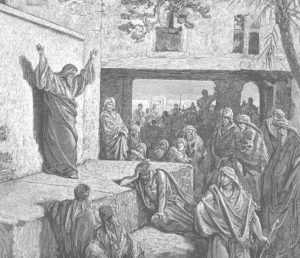
‘Micah Extorting the Israelites to Repentance’, by Gustave Doré
This is what the prophet Michah concluded when he, too, asked the same question as Moses did: “… And what does Hashem request of you? Only to act justly, and to love kindness, and to walk modestly with your God.” (Micah 6:8) Be just and treat everyone fairly; be kind and genuinely love to help others—and do it all humbly and modestly.
The Talmud (Shabbat 31a) takes a more literal approach, with Rava stating that God will ask each person six specific questions upon their death:
When man is led in for Judgment, he is asked: Did you deal faithfully? Did you fix times for learning? Did you engage in procreation? Did you hope for salvation? Did you engage in the dialectics of wisdom? Did you understand one thing from another?
The first question implies dealing honestly in business or in financial matters. Judaism has always taught the necessity of being scrupulously honest when it comes to money. The Kabbalists state that a person will be forced to reincarnate into this world if they so much as owe a single penny. They discuss how the value of shekel (שקל) is 430, equal to nefesh (נפש), “soul”, for each person’s material wealth is intricately tied to their spiritual nature. This is why giving money to charity can actually alter a person’s fate, as explained in the past. (See ‘How Charity Can Save Your Life’ in Garments of Light.)
Meanwhile, the Talmud holds that even though the Torah allows Jews to loan with interest to non-Jews, one shouldn’t charge interest from anyone, and a usurer might not even be a kosher witness in court (Sanhedrin 24b-25b). The same is true for someone who owes a lot of money. A person should not get themselves into great debt, and should ensure as much as possible that they will be able to repay a loan. This is why Rabbi Shimon, one of the five great students of Rabbi Yochanan ben Zakkai, held that the worst possible trait is that of a person who takes on debt and fails to repay (Avot 2:10). He bases himself on the words of King David: “The wicked man borrows and does not repay, but the righteous one is benevolent and gives.” (Psalms 37:21)
The wording of the Talmud is that a person will be asked if they took care of their finances b’emunah, “in faith”. Unfortunately, there are plenty of people who seem faithful, but engage in all kinds of financial tricks under the table. A person cannot be of great emunah if, at the same time, they cheat in financial matters, or are even a little bit dishonest with money. This includes gambling, stock market speculation, and all sorts of tax deceptions which have become so commonplace in our time.
The second question asked in the afterlife is whether a person set aside regular times to learn Torah. The Sages state that learning Torah is the most important mitzvah. Indeed, without learning Torah a person won’t know the right way to fulfil any mitzvah. The Torah is a “Tree of life for those who grasp it” (Proverbs 3:18), and the Sages quoted God stating: “I created the evil inclination, and I created the Torah as its antidote.” (Sifre Devarim 45) One who learns Torah is upholding the Covenant between God and Israel—since the Torah is the very text of that Covenant—and hence God states “If not for My covenant day and night, I would not have set the ordinances of Heaven and Earth.” (Jeremiah 33:25) God declares that He would not have created this universe were it not for His Torah—and His people upholding it day and night. (Some have therefore said that the world has time zones so that at any given moment, a Jew somewhere in the world is learning Torah.)
Similarly, the third question refers to procreation, for without it, too, humanity would cease to exist. More specifically, without Jewish procreation, there would be no Jews, and therefore no one to uphold that Covenant. The schools of Hillel and Shammai debated what it takes to fulfil the mitzvah of procreation (Yevamot 62a). According to Hillel, a person must have one boy and one girl, while according to Shammai, a person must have two boys and two girls. The reasoning of the latter is that Eve initially had four children: Cain, Abel, and the sisters each was born with. The first instance of pru u’rvu in the Torah resulted in two boys and two girls, so this is the standard for fulfilling the mitzvah.
However, the Talmud goes on to note another opinion that it was Shammai that taught one must have at least one boy and one girl, whereas Hillel taught that a person must simply have at least one child, whether boy or girl. The most lenient opinion, therefore, is that a person fulfils the mitzvah by having a single child, while the praiseworthy has at least two of each. A person who adopts a child or “raises an orphan” fulfils the mitzvah as well (Megillah 13a).
Of course, it isn’t enough just to have the kids. Parents need to invest their time and energy to ensure the children will be both righteous and successful. The Talmud (Kiddushin 29a) reminds us that, among other things, a parent is obligated to teach their child Torah, and also some kind of craft or career to ensure an honest livelihood. After all, “If there is no Torah, there is no flour; if there is no flour, there is no Torah.” (Avot 3:17) To raise children solely with Torah and assume a livelihood will come on its own, or to rely on the charity of others, is a gross sin. The Rambam (Hilkhot Talmud Torah 3:10) is particularly vocal about it:
Anyone who comes to the conclusion that he should involve himself in Torah study without doing work and derive his livelihood from charity, desecrates God’s Name, dishonors the Torah, extinguishes the light of faith, brings evil upon himself, and forfeits the life of the World to Come, for it is forbidden to derive benefit from the words of Torah in this world.
Our Sages declared: “Whoever benefits from the words of Torah forfeits his life in the world.” Also, they commanded and declared: “Do not make them a crown to magnify oneself, nor an axe to chop with.” Also, they commanded and declared: “Love work and despise rabbinic positions.” All Torah that is not accompanied by work will eventually be negated and lead to sin. Ultimately, such a person will steal from others.

Rabbi Moshe ben Maimon, the Rambam, aka. Maimonides, 1135-1204
Although the Rambam makes it clear that Torah study is of absolute importance, and should take precedence over one’s worldly occupation, he nonetheless reminds us that “the greatest sages of Israel were lumberjacks and water-drawers…” (ibid., 1:9) To be fair, there are other rabbinic authorities that allow for full-time Torah scholars who make learning their occupation, but this must only be for a minority of distinguished thinkers. It is certainly not a standard for everyone, for that would be completely unsustainable.
To get back to the third question, the Sages state that having children “hastens the Redemption”. There are a certain number of souls (in a Heavenly repository called “guf”) that must be born, and only when all of these souls have been born can Mashiach come. Thus, having children accelerates the time of Redemption.
This ties into the fourth question a person is asked: did they look forward to the Redemption? The wording is not if they waited for the Redemption, or hoped for it. Instead, whether they looked forward to it, suggesting a more active form. It isn’t enough to passively wait for the Redemption. Each person must do what they can to hasten it. This includes things like doing more acts of kindness and showing ahavat chinam, expressing baseless, non-judgemental love for all fellow Jews (Yoma 9b); engaging in kiruv; and, of course, repenting wholeheartedly (Sanhedrin 97b). Each person has to continue working on themselves to be ever-more righteous. Increasing one’s charitable donations hastens the Redemption, too (Isaiah 1:27 and Bava Batra 10a).
The final two questions deal with one’s knowledge and understanding. It isn’t enough to engage in light learning here and there. A person must be steeped in dialectics (pilpul) and understand the depths of one thing from another (davar mitokh davar). The Arizal taught that a person must learn Torah on all four of its levels; pshat (simple), remez (sub-textual), drash (metaphorical), and sod (secret). These levels are collectively known by the acronym pardes, “orchard”—a word that is also the origin of the English “paradise”. One who doesn’t learn Torah on all four levels has not fulfilled the mitzvah of Torah study and will return in a reincarnation to do so (Sha’ar HaGilgulim, 16).
The Arizal also taught that Torah study not only strengthens a person spiritually, but literally creates a “garment” for the soul to be worn in the World to Come (Sha’ar HaPesukim, Tehillim). This is the meaning of the verse “The Torah of Hashem is perfect, it restores the soul” (Psalms 19:8). Meanwhile, the power of Torah study is so great that it creates angels, and these angels could eventually communicate with the student and bestow Ruach HaKodesh, divine inspiration, upon them (Sha’ar Ruach HaKodesh, 1).
The Talmud specifies that one should spend a third of their time studying Tanakh, then a third studying Mishnah, and a third studying Gemara (Kiddushin 30a). This was at a time when no other texts were available, so one should probably make another “third” for the many other areas of Jewish study we have today, including halachic and midrashic literature, mussar, hashkafa, various responsas and commentaries, as well as Kabbalah. The Arizal divided up his Torah study routine as follows (Sha’ar HaMitzvot, Va’etchanan):
First, he would read the weekly Torah portion. On Sunday, he would focus on the first six verses. On Monday, the next four. On Tuesday, the next five, and on Wednesday the next six. Another five on Thursday, making a total of 26 verses, and then the whole parasha on Friday. This was done in the traditional manner, shnaim mikra v’echad targum—reading each verse twice in Hebrew, and once in Aramaic.
Next, he would study a portion of Nevi’im, the Prophets, followed by Ketuvim, the other Holy Writings that make up the Tanakh. This, too, was done with shnaim mikra and a targum. The Arizal then studied the Mishnah, followed by Gemara, together with the various commentaries. Finally, he engaged in Kabbalah.
Rava derived the six questions above from Isaiah 33:6, where the prophet declares, “And there shall be faith in your times; strength, salvation, wisdom and knowledge…” Faith refers to the first question regarding faithful business, times refers to the second question of setting times for Torah-learning, strength to procreation, salvation to the Redemption, wisdom and knowledge to the last two questions.
The Isaiah verse concludes with “… the fear of Hashem is His treasure.” One’s rewards (treasure) in the afterlife are contingent upon these six questions. Yet, what unifies them all is yirat Hashem, “fear” or “awe” of God.
One who is truly God-fearing will undoubtedly be scrupulously honest with financial matters, and strive to hasten the Redemption. It is doubtful that a Jew can be truly God-fearing without constantly meditating upon Torah and understanding its depths. Thus, complete yirat Hashem encompasses all of these things. Conversely, a person who does not live these ideals is probably not as God-fearing or faithful as they might believe themselves to be.
Judaism is famously built upon an “oral tradition”, or Oral Torah, that goes along with the Written Torah. The primary body of the Oral Torah is the Talmud. At the end of this week’s parasha, Mishpatim, the Torah states:
And Hashem said to Moses: “Ascend to Me on the mountain and be there, and I will give you the Tablets of Stone, and the Torah, and the mitzvah that I have written, that you may teach them…
The Talmud (Berakhot 5a) comments on this that the “Tablets” refers to the Ten Commandments, the “Torah” refers to the Five Books of Moses, the “mitzvah” is the Mishnah, “that I have written” are the books of the Prophets and Holy Writings, and “that you may teach them” is the Talmud. The Mishnah is the major corpus of ancient Jewish oral law, and the Talmud, or Gemara, is essentially a commentary on the Mishnah, with a deeper exposition and derivation of its laws. Today, the Mishnah is printed together with the corresponding Gemara, along with multiple super-commentaries laid out all around the page, and this whole is typically referred to as “Talmud”.
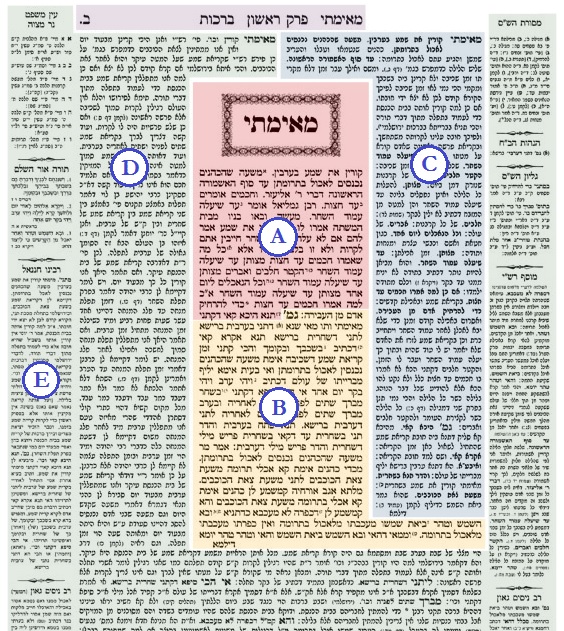
Anatomy of a page of Talmud: (A) Mishnah, (B) Gemara, (C) Commentary of Rashi, Rabbi Shlomo Itzchaki, 1040-1105, (D) Tosfot, a series of commentators following Rashi, (E) various additional commentaries around the edge of the page.
In the past, we’ve written how many have rejected the Talmud, starting with the ancient Sadducees, later the Karaites (whom some consider to be the spiritual descendants of the Sadducees), as well as the Samaritans, and many modern-day Jews whether secular or Reform. Such groups claim that either there was never such a thing as an “oral tradition” or “oral law”, or that the tradition is entirely man-made with no divine basis. Meanwhile, even in the Orthodox Jewish world there are those who are not quite sure what the Talmud truly is, and how its teachings should be regarded. It is therefore essential to explore the origins, development, importance, and necessity of the Talmud.
There are many ways to prove that there must be an oral tradition or Oral Torah. From the very beginning, we read in the Written Torah how God forged a covenant with Abraham, which passed down to Isaac, then Jacob, and so on. There is no mention of the patriarchs having any written text. These were oral teachings being passed down from one generation to the next.
Later, the Written Torah was given through the hand of Moses, yet many of its precepts are unclear. Numerous others do not seem to be relevant for all generations, and others still appear quite distasteful if taken literally. We have already written in the past that God did not intend for us to simply observe Torah law blindly and unquestioningly. (See ‘Do Jews Really Follow the Torah?’ in Garments of Light.) Rather, we are meant to toil in its words and extract its true meanings, evolve with it, and bring the Torah itself to life. The Torah is not a reference manual that sits on a shelf. It is likened to a living, breathing entity; a “tree of life for those who grasp it” (Proverbs 3:18).
Indeed, this is what Joshua commanded the nation: “This Torah shall not leave your mouth, and you shall meditate upon it day and night, so that you may observe to do like all that is written within it” (Joshua 1:8). Joshua did not say that we must literally observe all that is written in it (et kol hakatuv bo), but rather k’khol hakatuv bo, “like all that is written”, or similar to what is written there. We are not meant to simply memorize its laws and live by them, but rather to continuously discuss and debate the Torah, and meditate upon it day and night to derive fresh lessons from it.
Similarly, Exodus 34:27 states that “God said to Moses: ‘Write for yourself these words, for according to these words I have made a covenant with you and with Israel.’” Firstly, God told Moses to write the Torah for yourself, and would later remind that lo b’shamayim hi, the Torah “is not in Heaven” (Deuteronomy 30:12). It was given to us, for us to dwell upon and develop. Secondly, while the words above are translated as “according to these words”, the Hebrew is al pi hadevarim, literally “on the mouth”, which the Talmud says is a clear allusion to the Torah sh’be’al peh, the Oral Torah, literally “the Torah that is on the mouth”.

2000-year old tefillin discovered in Qumran
It is evident that by the start of the Common Era, Jews living in the Holy Land observed a wide array of customs and laws which were not explicitly mentioned in the Torah, or at least not explained in the Torah. For example, tefillin was quite common, and they have been found in the Qumran caves alongside the Dead Sea Scrolls (produced by a fringe Jewish group, likely the Essenes) and are even mentioned in the New Testament. Yet, while the Torah mentions binding something upon one’s arm and between one’s eyes four times, it does not say what these things are or what they look like. Naturally, the Sadducees (like the Karaites) did not wear tefillin, and understood the verses metaphorically. At the same time, though, the Sadducees (and the Karaites and Samaritans) did have mezuzot. Paradoxically, they took one verse in the passage literally (Deuteronomy 6:9), but the adjoining verse in the same passage (Deuteronomy 6:8) metaphorically!
This is just one example of many. The reality is that an oral tradition outside of the Written Law is absolutely vital to Judaism. Indeed, most of those anti-oral law groups still do have oral traditions and customs of their own, just not to the same extent and authority of the Talmud.
Regardless, after the massive devastation wrought by the Romans upon Israel during the 1st and 2nd centuries CE, many rabbis felt that the Oral Torah must be written down or else it might be lost. After the Bar Kochva Revolt (132-136 CE), the Talmud suggests there were less than a dozen genuine rabbis left in Israel. Judaism had to be rebuilt from the ashes. Shortly after, as soon as an opportunity presented itself, Rabbi Yehuda haNasi (who was very wealthy and well-connected) was able to put the Oral Torah into writing, likely with the assistance of fellow rabbis. The result is what is known as the Mishnah, and it was completed by about 200 CE.
The Mishnah is organized into six orders, which are further divided up into tractates. Zera’im (“Seeds”) is the first order, with 11 tractates mainly concerned with agricultural laws; followed by Mo’ed (holidays) with 12 tractates discussing Shabbat and festivals; Nashim (“Women”) with 7 tractates focusing on marriage; Nezikin (“Damages”) with 10 tractates of judicial and tort laws; Kodashim (holy things) with 11 tractates on ritual laws and offerings; and Tehorot (purities) with 12 tractates on cleanliness and ritual purity.
The root of the word “Mishnah” means to repeat, as it had been learned by recitation and repetition to commit the law to memory. Some have pointed out that Rabbi Yehuda haNasi may have used earlier Mishnahs compiled by Rabbi Akiva and one of his five remaining students, Rabbi Meir, who lived in the most difficult times of Roman persecution. Considering the circumstances of its composition, the Mishnah was written in short, terse language, with little to no explanation. It essentially presents only a set of laws, usually with multiple opinions on how each law should be fulfilled. To explain how the laws were derived from the Written Torah, and which opinions should be given precedence, another layer of text was necessary.
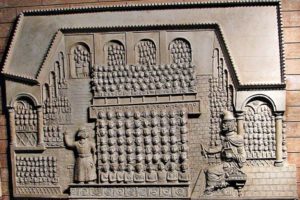
Rav Ashi teaching at the Sura Academy – a depiction from the Diaspora Museum in Tel Aviv
Gemara, from the Aramaic gamar, “to study” (like the Hebrew talmud), is that text which makes sense of the Mishnah. It was composed over the next three centuries, in two locations. Rabbis in the Holy Land produced the Talmud Yerushalmi, also known as the Jerusalem or Palestinian Talmud, while the Sages residing in Persia (centred in the former Babylonian territories) produced the Talmud Bavli, or the Babylonian Talmud. The Yerushalmi was unable to be completed as the persecutions in Israel reached their peak and the scholars could no longer continue their work. The Bavli was completed around 500, and its final composition is attributed to Ravina (Rav Avina bar Rav Huna), who concluded the process started by Rav Ashi (c. 352-427 CE) two generations earlier.
While incomplete, the Yerushalmi also has much more information on the agricultural laws, which were pertinent to those still living in Israel. In Persia, and for the majority of Jews living in the Diaspora, those agricultural laws were no longer relevant, so the Bavli does not have Gemaras on these Mishnaic tractates. Because the Yerushalmi was incomplete, and because it also discussed laws no longer necessary for most Jews, and because the Yerushalmi community was disbanded, it was ultimately the Talmud Bavli that became the dominant Gemara for the Jewish world. To this day, the Yerushalmi is generally only studied by those who already have a wide grasp of the Bavli.
The Talmud is far more than just an exposition on the Mishnah. It has both halachic (legal) and aggadic (literary or allegorical) aspects; contains discussions on ethics, history, mythology, prophecy, and mysticism; and speaks of other nations and religions, science, philosophy, economics, and just about everything else. It is a massive repository of wisdom, with a total of 2,711 double-sided pages (which is why the tractates are cited with a page number and side, for example Berakhot 2a or Shabbat 32b). This typically translates to about 6,200 normal pages in standard print format.
With so much information, it is easy to see why the Talmud went on to take such priority in Judaism. The Written Torah (the Tanakh as a whole) is quite short in comparison, and can be learned more quickly. It is important to remember that the Talmud did not replace the Tanakh, as many wrongly claim. The following graphic beautifully illustrates all of the Talmud’s citations to the Tanakh, and how the two are inseparable:
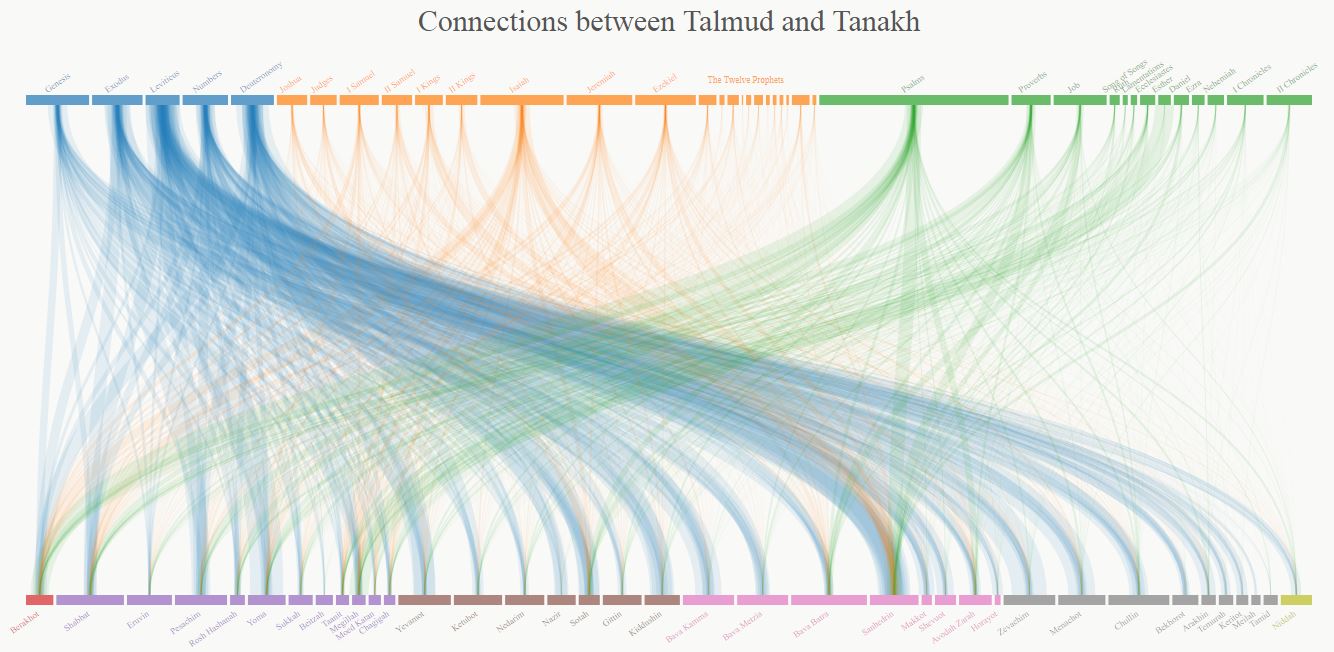
(Credit: Sefaria.org) It is said of the Vilna Gaon (Rabbi Eliyahu Kramer, 1720-1797) that past a certain age he only studied Tanakh, as he knew how to derive all of Judaism, including all of the Talmud, from it.
Indeed, it is difficult to properly grasp the entire Tanakh (which has its own host of apparent contradictions and perplexing passages) without the commentary of the Talmud. Once again, it is the Talmud that brings the Tanakh to life.
Partly because of this, Jews have been falsely accused in the past of abandoning Scripture in favour of the Talmud. This was a popular accusation among Christians in Europe. It is not without a grain of truth, for Ashkenazi Jews did tend to focus on Talmudic studies and less on other aspects of Judaism, Tanakh included. Meanwhile, the Sephardic Jewish world was known to be a bit better-rounded, incorporating more Scriptural, halachic, and philosophical study. Sephardic communities also tended to be more interested in mysticism, producing the bulk of early Kabbalistic literature. Ashkenazi communities eventually followed suit.
Ironically, so did many Christian groups, which eagerly embraced Jewish mysticism. Christian Knorr von Rosenroth (1636-1689) translated portions of the Zohar and Arizal into Latin, publishing the best-selling Kabbalah Denudata. Long before him, the Renaissance philosopher Pico della Mirandola (1463-1494), one of Michelangelo’s teachers, styled himself a “Christian Kabbalist”, as did the renowned scholar Johann Reuchlin (1455-1522). Meanwhile, Isaac Newton’s copy of the Zohar can be still found at Cambridge University. It is all the more ironic because Kabbalah itself is based on Talmudic principles, as derived from the Tanakh. For example, the central Kabbalistic concept of the Ten Sefirot is first mentioned in the Talmudic tractate of Chagigah (see page 12a), which also outlines the structure of the Heavenly realms. The Talmud is first to speak of the mystical study of Ma’aseh Beresheet (“Mysteries of Creation”) and Ma’aseh Merkavah (“Mysteries of the Divine Chariot”), of Sefer Yetzirah, of spiritual ascent, of how angels operate, and the mechanics of souls.
Having said all that, the Talmud is far from easy to navigate. While it contains vast riches of profound wisdom and divine information, it also has much that appears superfluous and sometimes outright boring. In fact, the Talmud (Sanhedrin 24a) itself admits that it is not called Talmud Bavli because it was composed in Babylon (since it really wasn’t) but because it is so mebulbal, “confused”, the root of Bavli, or Babel.
Of course, the Written Torah, too, at times appears superfluous, boring, or confused. The Midrash (another component of the Oral Torah) explains why: had the Torah been given in the correct order, with clear language, then anyone who read it would be “able to raise the dead and work miracles” (see Midrash Tehillim 3). The Torah—both Written and Oral—is put together in such a way that mastering it requires a lifetime of study, contemplation, and meditation. One must, as the sage Ben Bag Bag said (Avot 5:21), “turn it and turn it, for everything is in it; see through it, grow old with it, do not budge from it, for there is nothing better than it.”
There is one more accusation commonly directed at the Talmud. This is that the Talmud contains racist or xenophobic language, or perhaps immoral directives, or that it has many flaws and inaccuracies, or that it contains demonology and sorcery. Putting aside deliberate mistranslations and lies (which the internet is full of), the truth is that, taken out of context, certain rare passages in the vastness of the Talmud may be read that way. Again, the same is true for the Written Torah itself, where Scripture also speaks of demons and sorcery, has occasional xenophobic overtones, apparent contradictions, or directives that we today recognize as immoral.
 First of all, it is important that things are kept in their historical and textual context. Secondly, it is just as important to remember that the Talmud is not the code of Jewish law. (That would be the Shulchan Arukh, and others.) The Talmud presents many opinions, including non-Jewish sayings of various Roman figures, Greek philosophers, and Persian magi. Just because there is a certain strange statement in the Talmud does not mean that its origin is Jewish, and certainly does not mean that Jews necessarily subscribe to it. Even on matters of Jewish law and custom, multiple opinions are presented, most of which are ultimately rejected. The Talmud’s debates are like a transcript of a search for truth. False ideas will be encountered along the way. The Talmud presents them to us so that we can be aware of them, and learn from them.
First of all, it is important that things are kept in their historical and textual context. Secondly, it is just as important to remember that the Talmud is not the code of Jewish law. (That would be the Shulchan Arukh, and others.) The Talmud presents many opinions, including non-Jewish sayings of various Roman figures, Greek philosophers, and Persian magi. Just because there is a certain strange statement in the Talmud does not mean that its origin is Jewish, and certainly does not mean that Jews necessarily subscribe to it. Even on matters of Jewish law and custom, multiple opinions are presented, most of which are ultimately rejected. The Talmud’s debates are like a transcript of a search for truth. False ideas will be encountered along the way. The Talmud presents them to us so that we can be aware of them, and learn from them.
And yes, there are certain things in the Talmud—which are not based on the Torah itself—that may have become outdated and disproven. This is particularly the case with the Talmud’s scientific and medical knowledge. While much of this has incredibly stood the test of time and has been confirmed correct by modern science, there are others which we know today are inaccurate. This isn’t a new revelation. Long ago, Rav Sherira Gaon (c. 906-1006) stated that the Talmudic sages were not doctors, nor were they deriving medical remedies from the Torah. They were simply giving advice that was current at the time. The Rambam held the same (including Talmudic astronomy and mathematics under this category, see Moreh Nevuchim III, 14), as well as the Magen Avraham (Rabbi Avraham Gombiner, c. 1635-1682, on Orach Chaim 173:1) and Rav Shimshon Raphael Hirsch. One of the major medieval commentaries on the Talmud, Tosfot, admits that nature changes over time, which is why the Talmud’s science and medicine may not be accurate anymore. Nonetheless, there are those who maintain that we simply do not understand the Talmud properly—and this is probably true as well.
Whatever the case, the Talmud is an inseparable part of the Torah, and an integral aspect of Judaism. Possibly the greatest proof of its significance and divine nature is that it has kept the Jewish people alive and flourishing throughout the difficult centuries, while those who rejected the Oral Torah have mostly faded away. The Talmud remains among the most enigmatic texts of all time, and perhaps it is this mystique that brings some people to fear it. Thankfully, knowledge of the Talmud is growing around the world, and more people than ever before are taking an interest in, and benefitting from, its ancient wisdom.
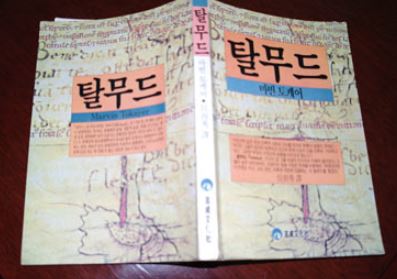
A bestselling Korean book about the Talmud. Fascination with the Talmud is particularly strong in the Far East. A Japanese book subtitled “Secrets of the Talmud Scriptures” (written by Rabbi Marvin Tokayer in 1971) sold over half a million copies in that country, and was soon exported to China and South Korea. More recently, a Korean reverend founded the “Shema Education Institute” and published a six-volume set of “Korean Talmud”, with plans to translate it into Chinese and Hindi. A simplified “Talmud” digest book became a bestseller, leading Korea’s ambassador to Israel to declare in 2011 that every Korean home has one. With the Winter Olympics coming up in Korea, it is appropriate to mention that Korean star speed skater Lee Kyou-Hyuk said several years ago: “I read the Talmud every time I am going through a hard time. It helps to calm my mind.”